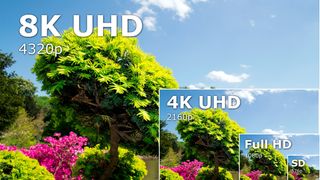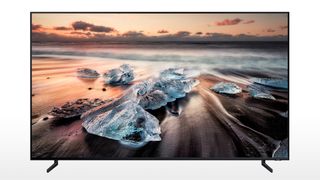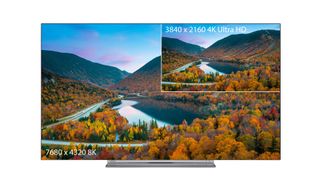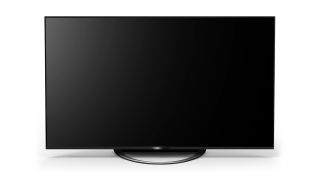8K TV is here: what you need to know about next-gen TV
Find out when you can get one, what it means for viewing, and whether it's worth it
So far there is only one 8K TV to buy and it is pretty epic. However, now Samsung has muscled open the door, there’s no putting this genie back in the bottle. Good mixed metaphor, huh? CES 2019 is awash with 8K and we’ll bring you the highlights of the ultra ultra HD revolution, in 8K (if you have an 8K monitor).
Though the world is only just getting to grips with the best 4K TVs, you can't stop the march of progress. 8K TVs are on-sale now, or at least one Samsung one is, and they make Ultra HD look like old hat. However, what does this move to 8K actually mean in practice? Here's your primer on what you need to know about the most advanced TV technology so far…
8K: WHAT RESOLUTION IS IT?

8K: a whole lotta pixels
A normal 8K TV will have a resolution of 7680x4320. Just as 4K TVs packed in four times the amount of pixels as Full HD TVs, 8K quadruples the resolution of Ultra HD.
This is a massive 33 million pixels per panel, meaning that most people's cameras aren't even able to fill it natively with a still image – it's that big and detailed.
All 8K TVs will have advanced upscaling abilities, to make sure that 4K or HD content looks good when the resolution is increased to fill the screen. Given that there's currently barely any 4K content available, upscaling HD will be what really sorts the best of the best sets from the also-rans.
What does 8K mean in terms of visual quality? Traditional 35mm film could be said to be about 6K, so we're beyond the level of detail even that is capable of. IMAX 70mm film is estimated to be more like 12K, but actually the digital effects for IMAX scenes tend to be created in 8K, and if that's good enough for Christopher Nolan, it's good enough for us. If you want a headline description of 8K, it's IMAX at home.
8K: HDR
8K TVs will no doubt be compatible with the current HDR formats, including HDR10, the dynamic HDR10+ upgrade to that, the more broadcast-friendly HLG and Dolby Vision. Although having said that, none of the TVs announced so far offer Dolby Vision support, and there will probably be new HDR systems along to make the most of 8K's resolution upgrade in due course.
8K: WHAT TVS ARE AVAILABLE?

The Samsung Q900R uses QLED tech for bright, vibrant images
The Samsung Q900R will be the first big 8K TV. It's due to arrive mid-October (price TBC), available in four sizes: 65-inch, 75-inch, 82-inch and 85-inch. It has advanced HDR too, promising a peak brightness of 4,000 nits (1,000 is good enough for true HDR), using the HDR10, HLG and HDR10+ standards.
It's a QLED TV, meaning that's the core tech is LCD rather than OLED, but it includes Samsung's Direct Full Array Elite backlight system, which means local dimming of the backlight can produce near-OLED levels of blackness, as seen in the fantastic Samsung Q9F.
Samsung will use an 8K AI upscaling system that it claims will make any source look 8K quality, but we'll see how those reruns of Cash in the Attic hold up once we get a full review.

Toshiba's 8K concept looks glorious, but won't go on sale soon
Toshiba has revealed a 65-inch 8K concept TV, equipped with HDR capabilities, including support for HDR10 and HLG, and a thin bezel design that shows off those pixels perfectly. The company says it plans to launch a set quickly… once content starts to become available. Which might be a slightly backhanded way of saying, "Not in the foreseeable future."
Like the Samsung, it's LCD instead of OLED, and features local dimming of the backlight, so offers rich black levels again. Toshiba's concept promises an upscaler that brings 4K images up to 8K quality perfectly.

Sharp's 80-inch 8K TV may come to Europe
Sharp has announced a new range of 8K TVs, at 60-inch, 70-inch and 80-inch sizes. Sharp says availability has yet to be confirmed, but that the 80-inch "should be available in European countries".
Vestel has also shown off a series of 8K TVs, including 65- and 75-inch models, but most intriguing was a 98-inch colossal set, with the panel built into a huge frame. This would really make the most of the resolution, and is true 'cinema at home' stuff, without the need for a projector.
LG has displayed a working prototype of an 88-inch 8K OLED TV. Its visual fidelity is absolutely stunning, but no actual product you can buy has looked likely so far. It's just for tech willy waving at trade shows such as IFA 2018.
8K: WHAT HDMI DO I NEED?
Now this is an important – and sexy – question. You can't use the one that came free with your DVD player in 2011, but there is a new HDMI standard that's capable of pushing the number of pixels required for 8K over a single cable. It's called HDMI 2.1, and it has three times the bandwidth of previous HDMI connections.
It's backwards compatible with previous HDMI connections, so it's all good for 4K or Full HD using your existing cables, but if you want to connect an 8K source to it, you may need a new higher-speed cable. Cables that are certified to use the full bandwidth of the new connection type are labelled Ultra High Speed HDMI. Woah.
8K: WHAT CAN I WATCH?
In native, pure, 8K? Flap all. Hollywood tends to use 6K cameras even when working digitally (and, as we suggested earlier, old films can only really be re-scanned to 6K), so content isn't exactly about to explode, either.
If you're in Japan, you could watch the first 8K television channel this year, due to launch in December. The idea is to make sure the tech is ready for a glorious 8K broadcast of the 2020 Olympics in Tokyo.
Various companies in countries all over the world have tested 8K transmissions, but mass rollouts aren't expected soon.
That said, Vimeo now has 8K support for videos, and YouTube likes to be at the forefront of these things, so streaming looks to be the future, assuming your internet can handle it.
Gaming in 8K is sort of possible if you have a ridiculously powerful PC – you'll need two of the highest-end graphics cards running in tandem. Don't expect 8K to be a feature of the next generation of games consoles.
So, then, you'll mostly be upscaling other content. But with a really good upscaler from 4K, you could still be making the most of those extra pixels, especially on a really big screen. From HD… We don't think that will look great – look at how SD looks even on the very best 4K tellies. SD upscaled to 8K will look like a Jackson Pollock.
8K: IS IT WORTH UPGRADING?
No 8K TVs have a price yet, but looking deep into our crystal ball, we have some news for you: they will be pricey AF, to put it in layman's terms.
If you live in an average-sized British home, it's not going to be worth it, unless you want to sit really close to the screen, giving an IMAX-like, eyeball-filling experience without losing any detail.
If you live in the sort of size of home that early adopters of new TV tech tend to enjoy – ie: very large – you may be better served by an 85-inch 8K OLED.
But either way, without a lot of content to offer, you'll be relying on the upscaling technology to make things look their best. Our advice: leave it a couple of years.

No comments:
Post a Comment